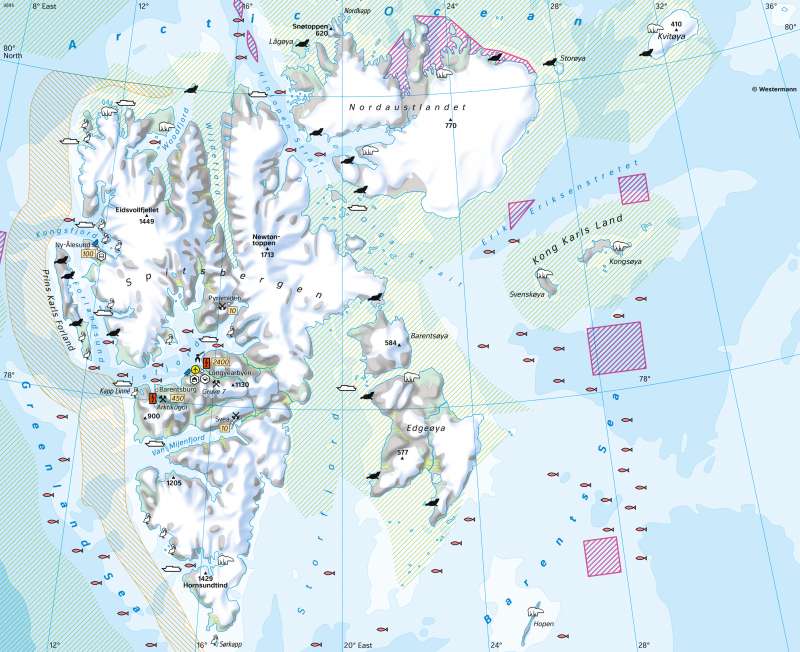Svalbard - Archipelago in Arctic environment
Human activities and environmental change
978-3-14-100890-6 | Page 201 | Ill. 3

Overview
In total, there are about 2400 permanent inhabitants (as of 2020) on Spitsbergen, the main island of Svalbard. Most of them live in the main town of Longyearbyen, where the University Centre in Svalbard (UNIS) is located. Due to the regular exchange of students, there is a lively influx and outflow of people. The university is the northernmost institute of higher education in the world. The research-based education of the next generation of Arctic experts is based on the subjects of biology, geology, geophysics and technology.
About another 450 people live in the Russian settlement of Barentsburg. The former Pyramid settlement was abandoned two years after the Russian coal mine closed in 1998. Other residents can be found in small numbers at research stations.
Tourism and wildlife in Svalbard
The Spitsbergen villages are not connected to each other by roads or paths. Therefore, important means of transport are aeroplane, ship and motor and dog sledges. The population is international, but is mainly made up of northern Europeans, Germans, some US Americans and Thais who work in hotel services. Remarkably, the population of about 2400 welcomes nearly 88,000 tourists annually from about 1500 ocean-going and expedition cruise ships (as of 2019). The number of tourists has almost tripled in the past 12 years. Tourism mainly takes place in Longyearbyen and on ships that circumnavigate the archipelago and offer shore tours. Besides the scenic attraction, cruise, expedition and day tourists are mainly attracted by the Arctic wildlife (polar bears, whales, walruses, seals), tax-free shopping or dog sledging. Outside the inhabited areas, however, there are no roads, hiking trails or trail markings. Thus, hikes usually have an expedition character and appropriate equipment for Antarctic conditions must be carried. This includes repellents to protect oneself from polar bears, which are, however, protected and may only be killed in self-defence. In addition to the polar bear, the Svalbard reindeer, the Arctic fox and, on the coasts, the walrus and various seal species are also found.
Due to the busy shipping traffic around Svalbard, rubbish has washed up on the shores. Shipping and especially the fishing fleet in the Barents Sea and in the waters of Spitsbergen are responsible for this. In addition to the physical pollution, tourists are thus confronted with aesthetic pollution of the beaches. Moreover, the rubbish poses a danger to animals, as they can get trapped in plastics, parts of fishing net and cut by metal waste. Meanwhile an initiative called "Clean Up Svalbard" came into being by which ship operators commit themselves to cleaning up a coastal strip for one hour per offered trip. In order to dispose of the rubbish completely, the governor of Svalbard also called on the inhabitants to take part in clean-up campaigns, which has been met by great interest. In the meantime, tourists are also being called upon to help by their expedition leaders.
Author: Sarah Franz
Economy
After initially being used as a base for whale, fox and seal hunting, the island developed into a mining region before the Second World War and then into a demilitarised zone that thrives on research, tourism and mining. A plant seed bank was also established. This collection is dedicated to the worldwide preservation of useful plants to ensure food for the world's population. The seed samples are stored 120 metres deep in permafrost at an ambient temperature of -18 °C. This is to protect them from genetic contamination, natural disasters, plant epidemics and nuclear wars. Coal production has been largely discontinued, as it is expensive and thus uneconomical compared to world market prices.




